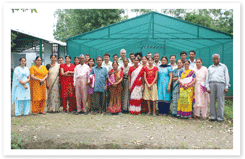 Dehradun-based Forest Research Institute has developed a village into a role model village showing what it takes to make a difference
Dehradun-based Forest Research Institute has developed a village into a role model village showing what it takes to make a difference
Shyampur village is just one of the many that dot the outskirts of Dehradun. Some 13 km from the heart of the state capital of Uttarakhand, it nestles in the lap of the first foothills of Himalaya of Sahaspur block. This small hamlet’s claim to fame – its Arcadia Gramsabha is India’s first model village adopted by the Forest Research Institute (FRI), Dehradun, in liaison with the Bagwan Gramodyog Samiti, a nongovernment organisation.
In 2008, as per the guidelines of the World Bank Project of Indian Council of Forestry Research & Education, a project proposal was put together by the FRI to develop a demonstration village in the vicinity of Dehradun. All this was part of a unique initiative to showcase the technologies developed by respective divisions of the FRI. Shyampur was identified and a MoU signed between the FRI and Bagwan Gramodyog Samiti. This was to mark the beginning of a new era for the village.
What followed in 2008-2009 was a marathon of awareness programmes and training for the locals, but not limited to them alone. Women and unemployed youth from surrounding villages were invited to partake in the training as well. Like most villages in the region, Shyampur too was dependent on wheat and paddy agriculture for its sustenance, but its liaison with the FRI was to change all that. Under this initiative, the focus of the villagers shifted to more lucrative crops such as cherry. Training was also imparted in raising nursery for cultivation and multiplication of forestry, medicinal and herbal plants such as aloe vera and stevia. On-site poplar tree cultivation was also taught.
Paramjit Singh, Extension Division, Sr F Scientist, under whose guidance the MoU was signed, takes great pride when he says, “What started as a small project has, at present, grown in leaps and bounds.” He recounts how in 2008, a plant nursery, along with a mist chamber, a composting unit and a green house was established by the Extension Division of the Institute. A training shed was also constructed on a priority basis to conduct various training courses in Shyampur. But that was just the a glimpse of what was to follow as expertise was taken from scientists from the Chemistry, Silviculture and Forest Products Divisions in nursery raising techniques of forestry, as well as medicinal; herbal and aromatic plants. Today the results are there for all to see.
Keeping themselves updated with the times, the villagers have taken to horticultural products like fish to water. They have learnt the skill of making pickles and juices as well as rearing honey bees and selling bottled organic honey. A perennial vermi-compost unit has been developed by the villagers for those who need compost for their crop any time of the year. They have done away with pesticides and fertilisers all together. What has caught the fancy of the women trainees, on the other hand, are bamboo table lamps, lantana furniture and LED bulbs.
Quite recently, mushroom cultivation in Ganoderma and Pleurotus was taught by scientists of the Pathology Division which, in turn, saw a lot of trainees returning to their farmlands to put their training to practice.
Today, Shyampur is walking on new turf as it explores and widens its scope. It has made the villagers self-sufficient and financially independent. Efforts such as these ensure that a big impetuous is given to the otherwise dwindling socio-economic status of the villages, which results in mass exodus from the hills. A total of 2,700 people have so far been trained in various fields. The numbers will, of course, only increase in the days and years to come.
As T S Bist, Founder of the Bagwan Gramodyog Samiti, puts it, “This liaison with the FRI has taken Shyampur to new heights. It is not only the villagers who have gained from these trainings. We have trained close to 3,000 people from not only Dehradun but from all over the hill state and those who came from as far as Manipur and Kashmir. Dignitaries such as Agatha Sangma, Digvijay Singh and R K Tolia have visited Shyampur to get a glimpse of our work. We feel privileged to be part of this process.”
Here’s wishing more power to such projects which have brought back a new way of life and livelihood to villagers who were otherwise set to join the mass exodus in search of a better future far away from home.
